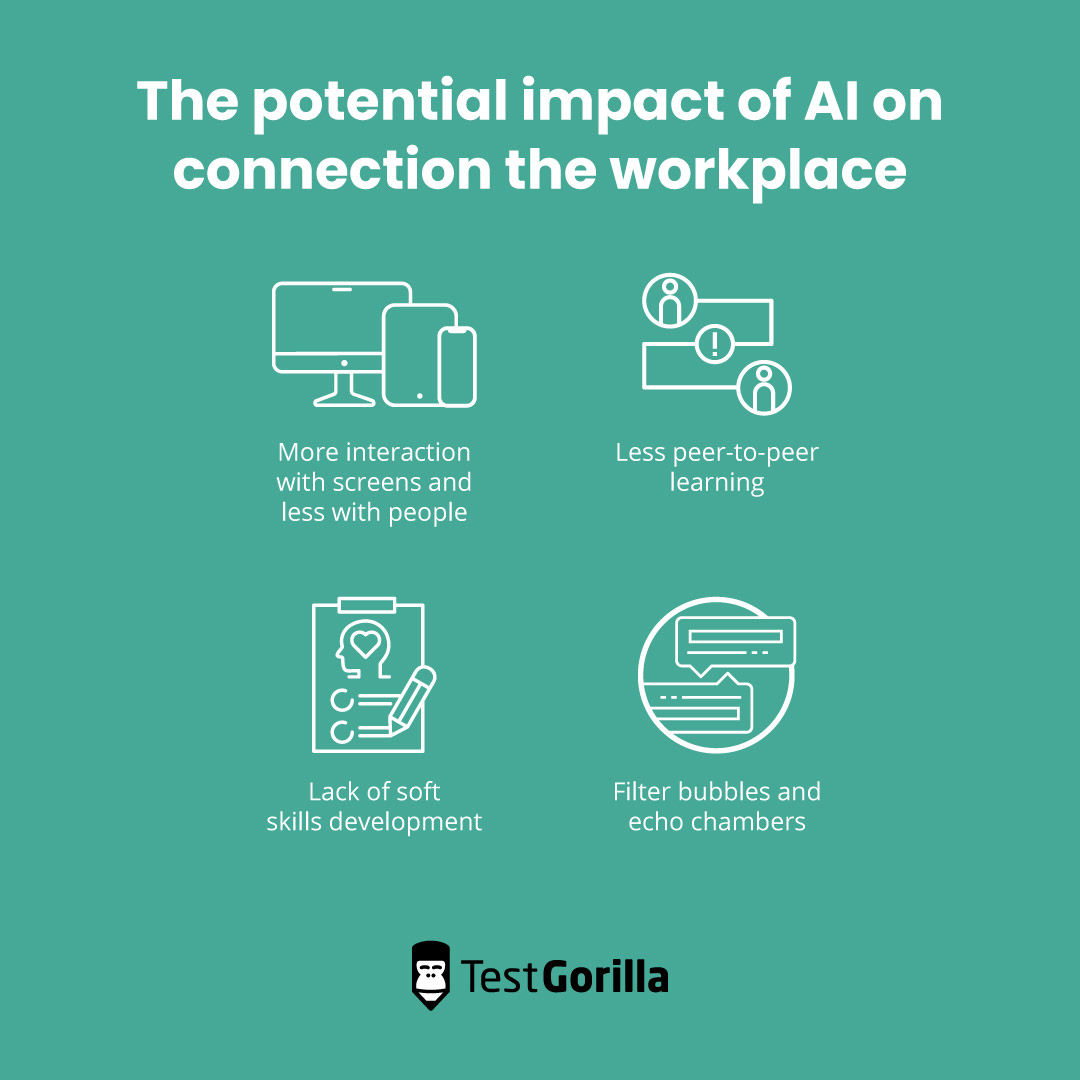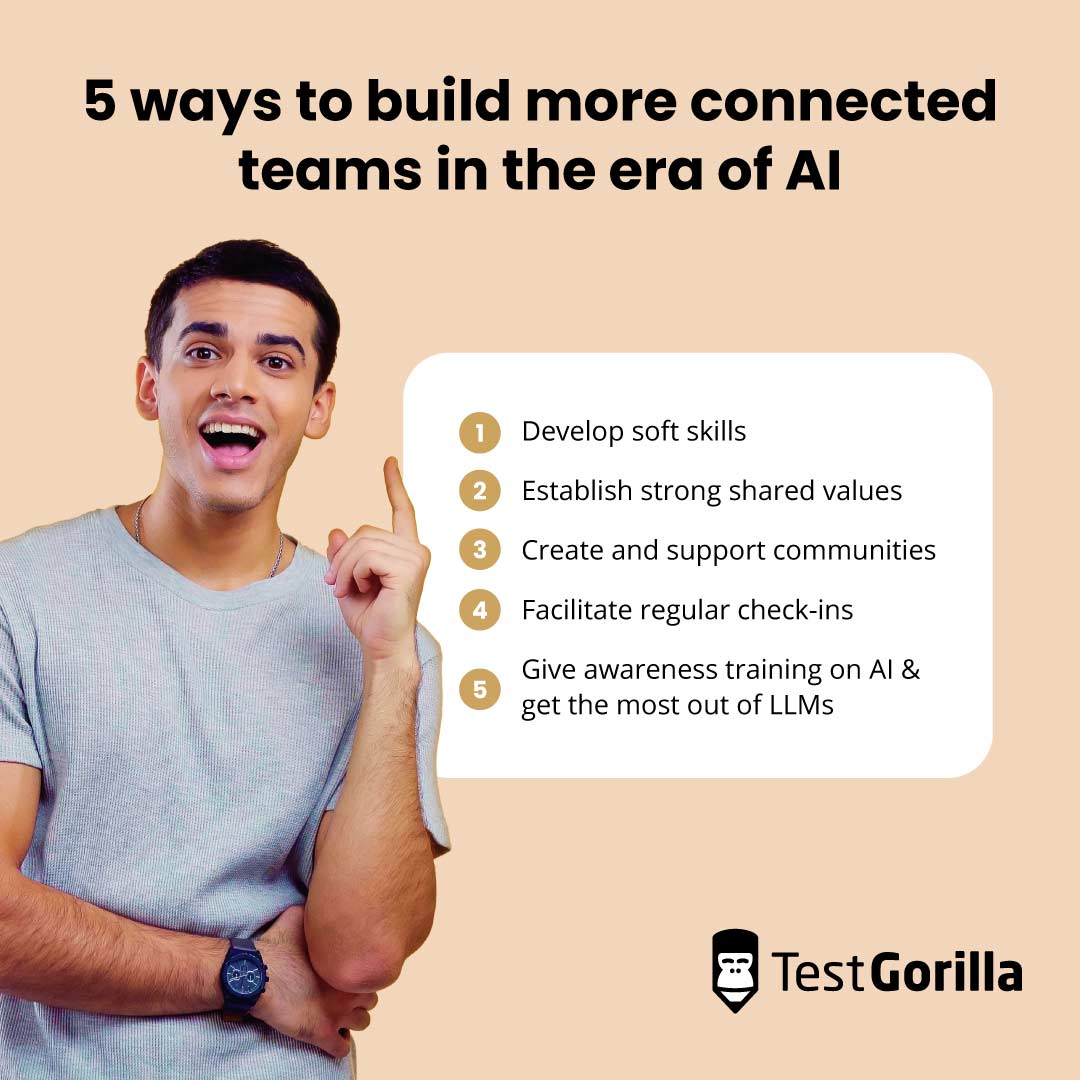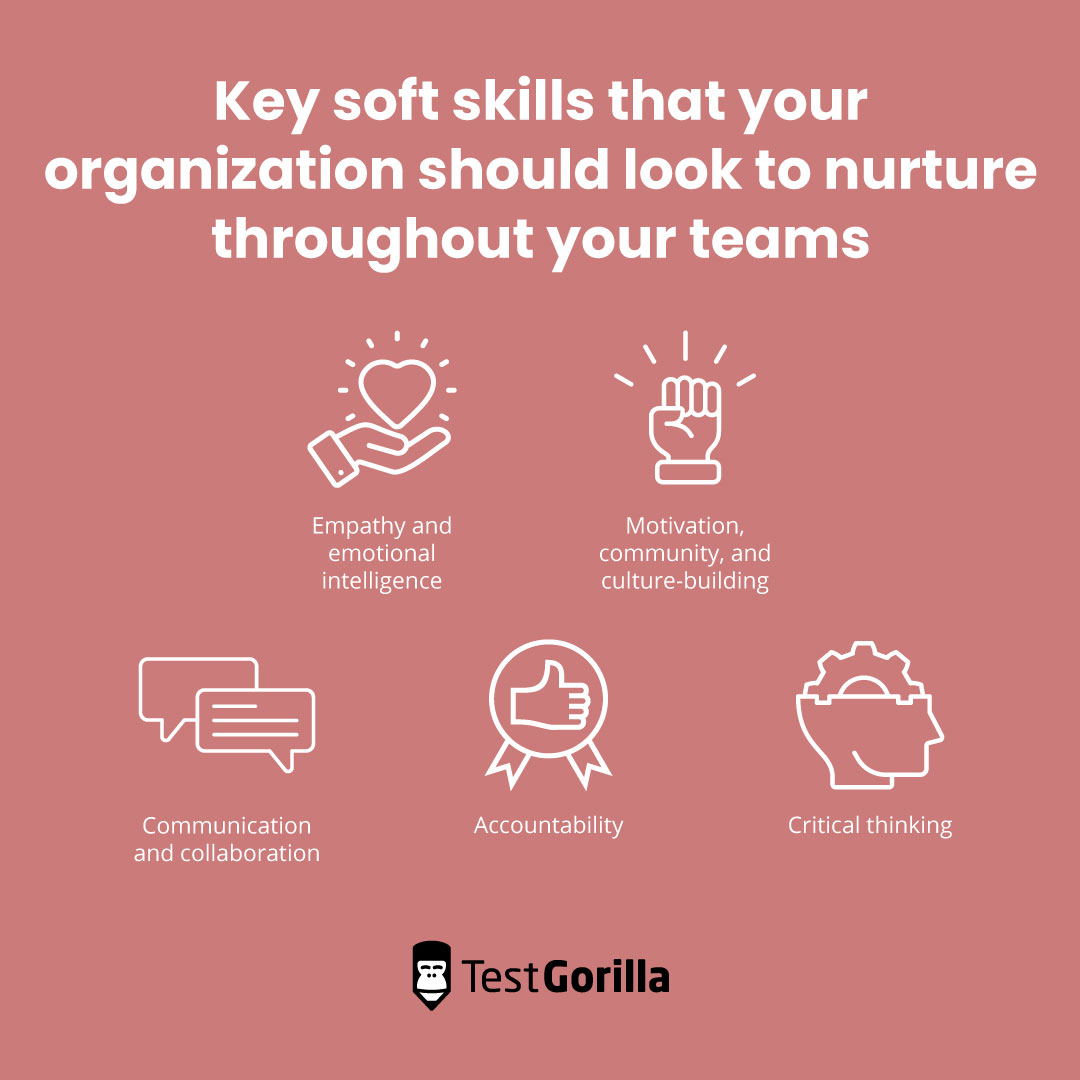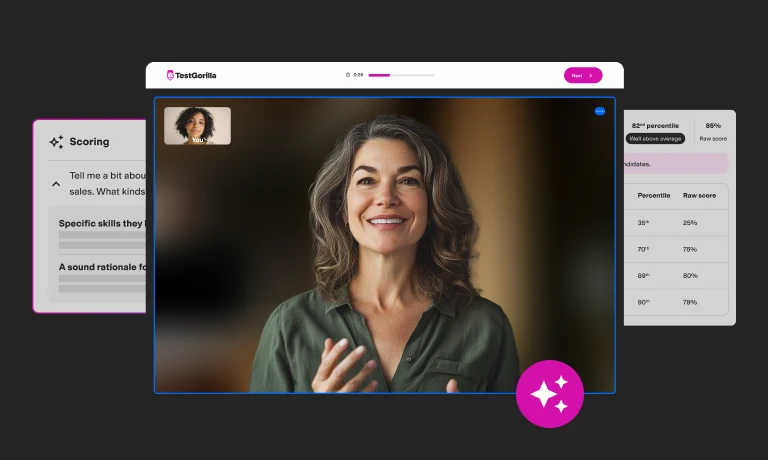AI could lead to a crisis of disconnection – 5 ways to build connected teams in the age of AI
If you’re a software developer, a few years ago you’d hop onto a pair programming session when you were having issues with your code. Today, you can use AI for debugging without having to reach out to a coworker for their help.
This is just one of countless examples of how AI is driving people to interact more with machines at work and less with each other. This shift in workplace practices will only accelerate as AI eliminates more and more support roles and diminishes the need for people to share knowledge.
In fact, many younger people are already used to interacting more with screens and machines than with other people face to face, thanks to social media and online learning. This means they may be entering the workplace without the soft skills needed to build the relationships that are essential for employee well-being, engagement, and job satisfaction.
In this article, we look at the ways AI could contribute to a greater sense of isolation in the workplace. We also discuss the strategies you can implement to not only build stronger, more connected, teams but also enhance the soft skills of your current talent, plus help them get the most out of AI tools.
The potential impact of AI on connection the workplace
AI technology is already having a profound impact on the way we go about daily tasks, from scheduling meetings to writing emails. In the workplace, this promises increased efficiency and productivity. However, increased dependence on automation and AI could also have the following negative effects on your employees.
More interactions with screens, fewer interactions with people
The issue of increased screen time leading to fewer interactions with people isn’t unique to AI – smartphones, streaming services, and social media are all examples of innovations that can reduce the time people spend together.
In the workplace, though, the impact of those technologies is relatively moderate. Compare that with AI technology, which is deliberately being introduced into our daily tasks and processes at an accelerating pace. As a result of this shift toward machine interactions, it makes sense that employees will have less need to communicate with each other.
Of course, it’s difficult to predict the impact of employee interactions becoming less frequent due to AI tools, but a recent paper published in the Journal of Applied Psychology hypothesized that “AI interaction frequency is positively related to employee’s need for affiliation.”[1] In other words, the more often people use AI technology, the more they yearn for positive social contact and interactions.
Less peer-to-peer learning
Peer-to-peer learning and collaborative work aren’t only useful because they empower employees to share knowledge, skills, and experiences – these practices also can play an important role in their work engagement and job satisfaction.
The Journal of Applied Psychology paper notes that “previously routine activities such as seeking a second opinion on a proposed solution for a client can now be provided instantaneously (and more accurately) by an AI system.”[1]
While this may be convenient, it may not always be the best thing for employees. For example, in a study of child welfare caseworkers, “Results indicated that caseworker job satisfaction increased as the quality of their ICP [interprofessional collaboration]...improved.” Based on these results, the study concluded that “agency leaders should foster and support IPC as a means of enhancing caseworker job satisfaction.”[2]
Therefore, more frequent interactions with AI may lead employees to feel socially disconnected from others, which can increase feelings of loneliness.
Lack of soft skills development
As people spend time working together, a few things happen: They develop valuable collaboration skills, they become better at communicating ideas accurately and efficiently, and they learn how to respond to and support each other’s needs with compassion.
With less collaboration, though, members of your team could experience inhibited personal growth in these and related areas. Also, with less contact time with employees, managers could find it hard to identify their potential areas of growth, leading them to have less influence on their team’s development across areas like problem-solving, critical thinking, and decision-making.
Furthermore, managers themselves may have less opportunity to develop their own managerial and people skills, including in areas such as team building, active listening, and conflict resolution.
A lack of development in these areas could contribute to employees experiencing a sense of stagnation and lack of fulfillment. Then, on the occasions when people in your organization have to work in direct contact with each other, this lack of soft skills and experience in collaboration might mean they struggle to achieve the desired results.
Filter bubbles and echo chambers
In the wake of the 2016 US election, the concepts of echo chambers and filter bubbles became hotly debated topics. These algorithm-influenced phenomena narrow the scope of people’s perspectives by exposing them to a limited range of ideas that reflect their own biases, search tendencies, and past behaviors.
Using highly complex algorithms, large language models (LLMs) like ChatGPT generate text based on data gathered from web content. As a result, they have the potential to replicate filter bubbles and contribute to echo chambers that reinforce people’s pre-existing ideas.[3]
In fact, a recent study looking at how “systems can influence user beliefs and preferences” found that algorithms that are capable of accurately predicting users’ interests are more likely to lead to filter bubbles and echo chambers.[4]
Therefore, if users rely too heavily on AI for their decision-making or information gathering – rather than their own critical thinking and a diverse range of research tools – they could develop very limited viewpoints. Consequently, this isolates them from their peers and stagnates personal growth.
5 ways to build more connected teams in the era of AI
The enormous excitement about AI is justified, but so is people’s concern for how it will affect their job prospects and employee experience. The following strategies will help you navigate some of the risks that AI poses so you can support your people and cultivate a community in your organization.
1. Develop soft skills
We said earlier that intensive reliance on AI tools has the potential to impair personal growth, including in the development of soft skills.
However, the influence of soft skills on the employee experience and people’s ability to connect with each other, not to mention the success of a team and organization in general, is so profound that it simply can’t be ignored.
That’s why you need to be intentional about hiring for skills in the AI era. Here are some key soft skills that your organization should look to nurture throughout your teams:
Empathy and emotional intelligence: These abilities help people better anticipate, understand, and respond to the needs and concerns of their teammates, managers, and clients.
Communication and collaboration: Collaborative skills are a core ingredient of success in specific project work and across entire organizations in the long term.
Motivation, community, and culture-building: These areas of soft skills relate closely to employee engagement so that, whatever job a team is tasked with, individuals within that team feel supported and driven to achieve their common goals.
Accountability: People need confidence to take on important responsibilities and recognize weaknesses in their own performance. This is crucial to building teams that trust each other and can depend on each other when necessary.
Critical thinking: As discussed above, people need to question sources to develop informed ideas that can positively contribute to the decision-making process.
Some of the discussion points below can contribute to your teams developing better interpersonal, interpretive, and collaborative skills. First, though, an assessment of your employees’ abilities and needs will help you identify potential areas of growth.
You can use skills-based tests to do this – for example, some of TestGorilla’s cognitive ability tests include:
2. Establish strong shared values
When people share the same values, and those values promote strong communication, collaboration, and support, they feel a stronger sense of connection to each other and perform better as a whole.
In support of this idea, a study on project leadership found that sharing values was “a factor for improving the performance in projects.”[5] Other studies back this up, with evidence showing that with a greater sense of belonging in the workplace, job performance increases by 56%, employee turnover reduces by 50%, and employees take 75% fewer sick days.[6]
To help you foster a positive work environment of shared values, look to your hiring processes. How are you identifying whether candidates align with your organization’s values? With TestGorilla’s Culture Add test, for example, you can identify candidates whose values not only align with your organization’s, but contribute to improving the existing culture.
To support existing employees, offer ongoing training and development programs, and go over your values in all-hands meetings. You can even shout out employees who have particularly embodied one of your values in the past month or quarter, providing positive reinforcement for team members who live by and uphold your values.
3. Create and support communities
As well as helping to reinforce your company’s values, strong communities help your people avoid isolation, giving them the opportunity to understand each other’s communication styles. Additionally, by forming part of a community, your employees will improve at sharing knowledge, developing empathy, and working together.
Team building activities like outdoor or virtual treasure hunts, quizzes, or organized excursions can all be effective ways to get teams interacting, forming bonds, and learning about each other.
Equally, you can help promote a sense of community within your organization by using virtual tools like Donut. The platform automatically schedules regular coffee chats between randomized pairs of team members, giving them an opportunity to speak with colleagues they wouldn’t normally interact with.
On the other hand, employee resource groups (ERGs) are especially effective at fostering inclusion and diversity in organizations, which can help to retain your best talent and improve productivity.
4. Facilitate regular check-ins
Naturally, it’s important for managers to provide employees with an opportunity to meet with them, reflect on their performance, and discuss their needs.
Weekly, bi-weekly, or monthly scheduled one-to-one meetings are one good way to do this, but not the only way. Managers can also hold open office hours, which work as a designated slot each week where employees can drop in for a catch-up or to discuss a specific issue.
You can provide support to your managers to help them make the most of their one-to-ones by emphasizing that chats with team members shouldn’t be exclusively about performance – it’s also important to discuss goals, challenges, and job satisfaction.
Helpful questions managers can ask to encourage openness and foster casual yet productive meetings with their team members include:
What's the biggest challenge you're facing right now?
Are there any issues I can help address for you?
What skills would you like to develop?
How can I support your current goals?
How's your relationship with the rest of the team?
Is there anything we could improve about team meetings?
How are you managing your workload?
Is your work-life balance okay? Do you feel burnt out?
Not only will regular check-ins with employees help managers understand them better and learn about their challenges, but they’ll also give managers the opportunity to develop their people skills and play a more active role in their team’s ongoing development.
5. Give awareness training on AI & get the most out of LLMs
Online awareness training is usually focused on tech security and plays an important role in developing a culture of safety and privacy sensitivity across your organization. However, mindfulness about how best to utilize and interact with AI tools can also be a key feature of your tech training programs.
With a considered and informed approach to how your employees manage LLMs as a resource in the workplace, they can avoid some of the pitfalls of over-reliance that we’ve discussed in this piece. For example, Cornell University has provided some guidelines on using AI ethically, which includes a list of questions for instructors and students to consider. These include:
Is the AI-generated content accurate? How can you test or assess the accuracy?
Can other credible sources (outside of generative AI) validate the data or item produced?
Who is represented in this data? Is the data inclusive in terms of the material’s scope and the perspectives that it presents?
It is also important to emphasize that the use of AI within any workplace context should be transparent, and its output shared responsibly. This is especially true in light of the possibility of AI hallucinations, where LLMs essentially ‘invent’ information or data points, and the ability of tools that generate deepfakes to mislead.
Meanwhile, Google’s guidelines on responsible practices for AI deployment are:
Use a human-centered design approach
Identify multiple metrics to assess training and monitoring
When possible, directly examine your raw data
Understand the limitations of your dataset and model
Test, Test, Test
Continue to monitor and update the system after deployment
With a culture of AI awareness in your organization, your teams can better recognize AI tools for what they are – a technology to amplify people’s ability to complete tasks, not something that should replace the value of human interaction, problem-solving, and collaboration.
The best insights on HR and recruitment, delivered to your inbox.
Biweekly updates. No spam. Unsubscribe any time.
Create stronger teams to minimize the risk of disconnection
As we’ve seen, heavy use of AI can contribute to a sense of isolation among your employees, affect their ability to develop soft skills, and limit how well they collaborate with each other. With a responsible approach to AI use, though, you can mitigate these risks.
Working to develop the communities in your organization can play a part in this process, as can the creation and reinforcement of shared goals.
Additionally, using skills-based testing in your hiring process and to identify current employees’ skills gaps will help you build and nurture stronger teams who align with and enhance your organization’s core values.
The State of Skills-Based Hiring 2025
Read TestGorilla's annual report to discover why 85% of companies are choosing skills-based hiring s in 2025.
Sources:
1. "No Person Is an Island: Unpacking the Work and After-Work Consequences of Interacting With Artificial Intelligence." (2023). Journal of Applied Psychology. Retrieved October 21, 2023. https://www.apa.org/pubs/journals/releases/apl-apl0001103.pdf
2. "A Quantitative Study of the Relationship Between Interprofessional Collaboration and Job Satisfaction Among Child Welfare Caseworkers." (2023). Families in Society: The Journal of Contemporary Social Services. Retrieved October 21, 2023. https://journals.sagepub.com/doi/abs/10.1177/10443894231182170
3. "DeepMind is asking how AI helped turn the internet into an echo chamber.” (2019). MIT Technology Review. Retrieved October 21, 2023. https://www.technologyreview.com/2019/03/07/65984/deepmind-is-asking-how-google-helped-turn-the-internet-into-an-echo-chamber/
4. "Degenerate Feedback Loops in Recommender Systems." (2019). Cornell University. Retrieved October 21, 2023. https://arxiv.org/abs/1902.10730
5. "The Relevance of Sharing Values in Project Leadership." (2023). Open Journal of Business and Management. Retrieved October 21, 2023. https://www.scirp.org/pdf/ojbm_2023011115443505.pdf
6. "The Value of Belonging at Work: Investing in Workplace Inclusion." (2023). BetterUp. Retrieved October 21, 2023. https://grow.betterup.com/resources/the-value-of-belonging-at-work-the-business-case-for-investing-in-workplace-inclusion-event
Related posts
You've scrolled this far
Why not try TestGorilla for free, and see what happens when you put skills first.






















